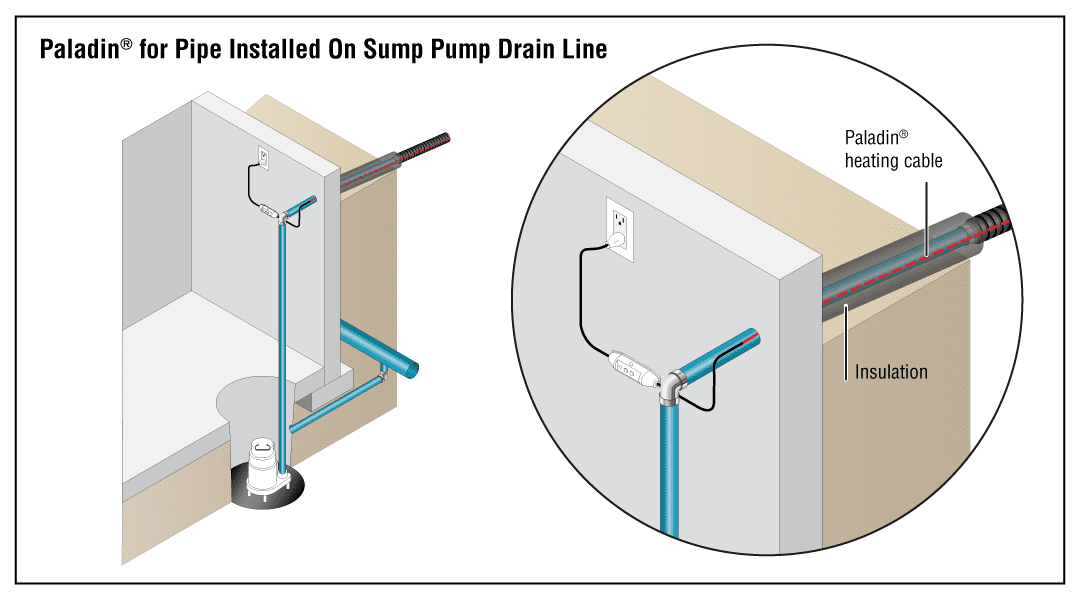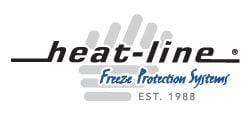How to Prevent a Frozen Sump Pump Discharge Line
A dependable sump pump is essential to prevent the hassle and damage of a flooded basement. But even if your sump pump is installed correctly, your system is still vulnerable to a frozen sump pump discharge line during extended cold weather. If your sump pump drain is frozen, your discharge line pipe or sump pump hose will block water from being pumped out, causing your system to fail. When the discharge line is blocked by ice, your pump will no longer drain water from your basement. This can lead to a flooded basement and damage to the pump from overheating, as the pump will run constantly to try and clear the water. Fortunately, Heat-Line offers safe and reliable solutions to prevent a frozen sump pump discharge line – saving you from expensive repairs and water damage.
Since not all sump pump setups are the same, Heat-Line offers different heating cable solutions tailored to your situation, such as an existing drain pipe, a new sump pump or drain line installation, and whether or not you have access to the outside of the pipe.
There are 4 ways to prevent a frozen sump pump discharge line with Heat-Line products.
1. Install the Paladin system on the outside of an existing sump pump discharge pipe.
2. Install the Paladin system on the discharge pipe and in the gravity drain.
3. Install the Retro-Line system inside an existing sump pump drain pipe.
4. Install the Heat-Line system as a new sump pump drain pipe.
Whatever solution you choose, it’s important to note that, unlike outdated hardware store heat tape, Heat-Line brand self-regulating heating cable systems present no danger of overheating or melting a sump pump drain line. All Heat-Line brand heating cable systems employ self-regulating technology; this important feature means that the heating cable will increase and decrease its heat output in response to temperature. Sump pump drain lines are especially at risk of overheating when using outdated heat tape, as the drainpipes are often non-metallic and intermittently dry. This is why Heat-Line self-regulating heating cables are critical in preventing overheating or melting of the pipe. Another advantage of Heat-Line self-regulating heating cables is that they are safe to insulate. Insulation not only improves the energy efficiency of the heating cable system but also ensures complete freeze protection for exposed above-ground pipes. This aspect is particularly crucial, given that sump pump discharge lines are often routed outside above ground.
Now let’s take a closer look at the 4 best ways to prevent a frozen sump pump discharge line.
1. Install the Paladin System on the Outside of an Existing Discharge Pipe.
When installing a heating cable on the outside of a sump pump drain pipe is preferred, the Paladin self-regulating heating cable system is an easy way to protect your drain line from freezing. Paladin is supplied job-ready as a plug-in unit with a GFCI-protected power lead and is factory-finished to length.
Paladin systems can be used on all metal and non-metal sump pump drain pipes. Due to the high-performance capability of the conductive polymer technology, Paladin is applied on the outside of the pipe and is generally used in a single run. Paladin is approved for wet locations and is suitable for direct burial in soil. If necessary, it can be installed within freshwater drainage tiles and around tanks as part of a sump pump drainage system.


2. Install the Paladin System On the Discharge Pipe and In the Gravity Drain.
While the Paladin heating cable is designed for external heat tracing, it can also be used on the inside of drain pipes, such as a sump pump drain, given its wet location approval. Paladin can be used in metal and non-metal small or larger diameter drain pipes. It can be inserted into gravity-fed (non-pressurized) drain pipes as long as there is access to an open end and a watertight entry seal isn’t required. If the outlet of the drain pipe is exposed, it is recommended to double back or dual trace the last 2-5 ft. (0.6m – 1.5m) of the drain. If a plumbing setup will allow it, this method may be preferable as it could be more accessible and less costly to install than other options.


3. Install the Retro-Line System on the Inside of an Existing Sump Pump Drain Pipe
When installing a heating cable on the outside of a sump pump drain pipe is not possible or desirable, you can use the Retro-Line internal self-regulating heating cable system.
This can be very useful when access to the drain pipe or hose is limited due to its being buried, as you do not have to excavate the pipe to apply the heating cable. Supplied with a compression style fitting for connection to the pipe, Retro-Line can be easily and quickly installed in most existing pipes without having to remove them. Once installed, the system is plugged into a 120V or 240V receptacle, so no extra electrical work is required.


This video shows how Retro-Line can be installed in an existing sump pump drain line.
While not as common, we have had requests over the years for a product that will work inside small-diameter pipes and hoses. To address this, we recently released our newest solution, Retro-Line Mini. Even small-diameter pipes as small as ½ inch (with a minimum inside diameter of 0.485 inch or greater) in diameter can be protected internally. Employing the same advanced self-regulating heating cable technology, the Retro-Line Mini is compatible with both metallic and non-metallic pipes. The system is job-ready and has all the necessary plumbing fittings and power supply.
Proven to perform in the most extreme cold, both Retro-Line and the Retro-Line Mini exceed the highest quality standards and certifications in North America and utilize Heat-Line’s self-regulating technology, ensuring pipes are never at risk of melting or overheating, even when dry.
4. Install the Heat-Line System as a New Sump Pump Drain Pipe.
If you’re considering installing a new sump pump system or replacing an old drain pipe line, this is an excellent opportunity to protect your system right from the start. The Heat-Line system combines the advanced in-pipe self-regulating Retro-Line heating cable system with a 75 PSI certified CSA polyethylene pipe, which is factory installed inside the pipe and ready for installation. Just roll out the pipe and hook it up to your sump pump for a quick and easy installation. Heat-Line can be installed above ground or shallow buried below ground, depending on how you will be draining the sump pump discharge. Heat-Line can be shallow buried below ground and provide reliable freeze protection without being buried below the frost line. Heat-Line can also be installed above ground provided it is insulated. It has been proven to keep water from freezing at -40ºC/F when installed above ground with 3/4 inch thick pipe insulation. Digging or blasting rock is unnecessary to bury the pipe. The proactive approach will ensure you never have to deal with any issues that can occur when your sump pump drain is frozen.
All four options offer easy installation and safe, reliable, and energy-efficient ways to protect you from a frozen sump pump discharge line. Whichever solution you choose, you will have peace of mind knowing that you no longer need to worry about the aggravation and expense that is caused when a sump pump drain is frozen.




